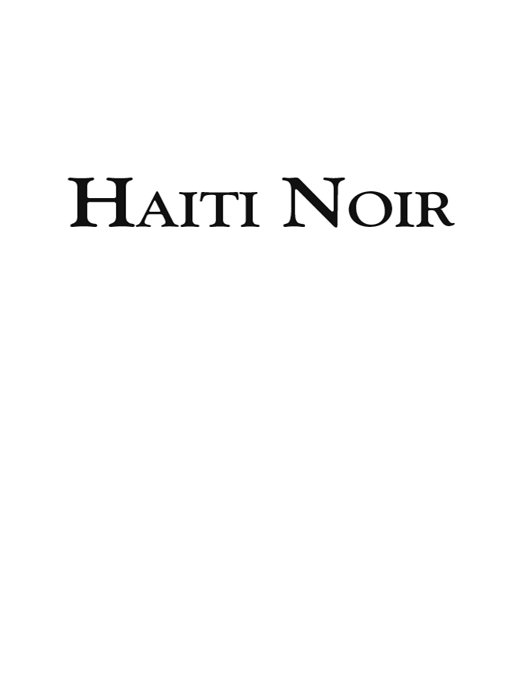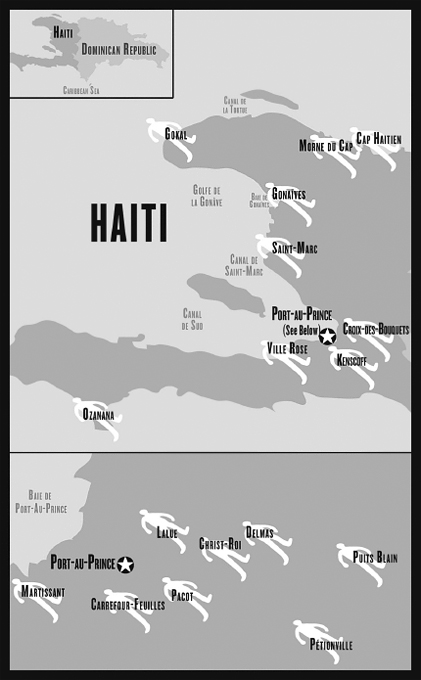Haiti Noir




This collection is comprised of works of fiction. All names, characters, places, and incidents are the product of the authors’ imaginations. Any resemblance to real events or persons, living or dead, is entirely coincidental.
Published by Akashic Books
© 2011 Akashic Books
Series concept by Tim McLoughlin and Johnny Temple
Haiti map by Aaron Petrovich
“Twenty Dollars” by Madison Smartt Bell ©2011 by Madison Smartt Bell; “The Finger” by Gary Victor was originally published in French as “Le doigt,” in
Treize nouvelles vaudou
(Mémoire d’encrier, Montreal).
eISBN-13: 978-1-617-75012-0
Hardcover ISBN-13: 978-1-61775-013-7
Hardcover Library of Congress Control Number: 2010935891
Trade Paperback ISBN-13: 978-1-936070-65-7
Library of Congress Control Number: 2010922715
All rights reserved
Akashic Books
PO Box 1456
New York, NY 10009
A
LSO IN THE
A
KASHIC
N
OIR
S
ERIES:
Baltimore Noir
, edited by Laura Lippman
Boston Noir
, edited by Dennis Lehane
Bronx Noir
, edited by S.J. Rozan
Brooklyn Noir
, edited by Tim McLoughlin
Brooklyn Noir 2: The Classics
, edited by Tim McLoughlin
Brooklyn Noir 3: Nothing but the Truth
edited by Tim McLoughlin & Thomas Adcock
Chicago Noir
, edited by Neal Pollack
Copenhagen Noir
(Denmark), edited by Bo Tao Michaëlis
D.C. Noir
, edited by George Pelecanos
D.C. Noir 2: The Classics
, edited by George Pelecanos
Delhi Noir
(India), edited by Hirsh Sawhney
Detroit Noir
, edited by E.J. Olsen & John C. Hocking
Dublin Noir
(Ireland), edited by Ken Bruen
Havana Noir
(Cuba), edited by Achy Obejas
Indian Country Noir
, edited by Sarah Cortez & Liz Martínez
Istanbul Noir
(Turkey), edited by Mustafa Ziyalan & Amy Spangler
Las Vegas Noir
, edited by Jarret Keene & Todd James Pierce
London Noir
(England), edited by Cathi Unsworth
Lone Star Noir
, edited by Bobby Byrd & Johnny Byrd
Los Angeles Noir
, edited by Denise Hamilton
Los Angeles Noir 2: The Classics
, edited by Denise Hamilton
Manhattan Noir
, edited by Lawrence Block
Manhattan Noir 2: The Classics
, edited by Lawrence Block
Mexico City Noir
(Mexico), edited by Paco I. Taibo II
Miami Noir
, edited by Les Standiford
Moscow Noir
(Russia), edited by Natalia Smirnova & Julia Goumen
New Orleans Noir
, edited by Julie Smith
Orange County Noir
, edited by Gary Phillips
Paris Noir
(France), edited by Aurélien Masson
Philadelphia Noir
, edited by Carlin Romano
Phoenix Noir
, edited by Patrick Millikin
Portland Noir
, edited by Kevin Sampsell
Queens Noir
, edited by Robert Knightly
Richmond Noir,
edited by Andrew Blossom,
Brian Castleberry & Tom De Haven
Rome Noir
(Italy), edited by Chiara Stangalino & Maxim Jakubowski
San Francisco Noir
, edited by Peter Maravelis
San Francisco Noir 2: The Classics
, edited by Peter Maravelis
Seattle Noir
, edited by Curt Colbert
Toronto Noir
(Canada), edited by Janine Armin & Nathaniel G. Moore
Trinidad Noir
, edited by Lisa Allen-Agostini & Jeanne Mason
Twin Cities Noir
, edited by Julie Schaper & Steven Horwitz
Wall Street Noir
, edited by Peter Spiegelman
F
ORTHCOMING:
Barcelona Noir
(Spain), edited by Adriana Lopez & Carmen Ospina
Cape Cod Noir
, edited by David L. Ulin
Lagos Noir
(Nigeria), edited by Chris Abani
Mumbai Noir
(India), edited by Altaf Tyrewala
Pittsburgh Noir
, edited by Kathleen George
San Diego Noir
, edited by Maryelizabeth Hart
Venice Noir
(Italy), edited by Maxim Jakubowski

T
ABLE OF
C
ONTENTS
M
ADISON
S
MARTT
B
ELL
Morne du Cap
L
OUIS
-P
HILIPPE
D
ALEMBERT
Pétionville
M
ARVIN
V
ICTOR
Carrefour-Feuilles
I
began working on this anthology about a year before January 12, 2010, when Haiti was struck by its worst natural disaster in over two hundred years. The world knows now that more than two hundred thousand people died and over a million lost their homes in Haiti’s capital and the surrounding cities of Léogâne, Petit-Goâve, and Jacmel. As I am writing these words, survivors remain huddled by the thousands in displacement camps, most shielding themselves from intermittent rain with nothing but wooden posts and bedsheets.
Even before the earthquake, life was not easy in Haiti. There was always the risk of dying from hunger, an infectious disease, a natural disaster, or a crime. But there was also hope, laughter, and boundless creativity. Haitian creativity has always been one of the country’s most identifiable survival traits. Whether expressed in vibrant and colorful paintings, double entendre–filled spiritual or party music, or the poignant, humorous, erotic, lyrical (and yes, also dark) short stories and novels of its writers, Haiti’s more nuanced and complex face often comes across in its arts.
When I began seeking submissions for this book, many of the writers I contacted, both inside and outside of Haiti, would comment on the suitability of the title
Haiti Noir
.
“I know you inherited it from the series,” one of them said, “but it certainly is fitting.”
Noir of course means—among other things—black, and Haiti became the first black republic in the Western Hemisphere when it was established by former slaves in 1804. Noir (nwa in Creole), as the scholar Jana Evans Braziel points out in her book
Artists, Performers, and Black Masculinity in the
Haitian Diaspora
, also refers to any Haitian citizen, regardless of race. The founders of the republic designated it that way so that even the Polish soldiers who deserted the French to fight alongside Haitians during their battle for independence were considered “noirs,” while all other foreigners, of whatever race, were considered “blancs” (blan in Creole).
The irony of these designations struck me recently as I was rereading what I consider the most historically “noir” stories that link Haiti and the United States. The stories I am thinking of are those self-designated “dark tales” written by United States Marines who were stationed in the country during the American occupation that began in 1915 and ended in 1934. Over those nineteen years, Haiti was fertile ground for cannibal-and zombie-filled soldier memoirs and fear-provoking Hollywood B movies. Claiming to recount firsthand tales of “woolly-headed cannibals,” books such as Captain John Houston Craige’s
Black Bagdad
and
Cannibal Cousins,
along with William Seabrook’s
The Magic Island
and Richard Loederer’s
Voodoo Fire in Haiti
, shrouded Haiti in a kind of mystery that aimed to stereotype and dehumanize its people. I am certainly not one to censor any writer, but sentences like this one from
Voodoo Fire in Haiti
, send chills down my back:
Laugh at the negroes! You understand them as little as
they understand you. The black race is far closer to the
earth than the white, and for that reason they are happier
than all the white men put together. A negro believes without
asking why; he submits to nature.
This is as understanding as it gets, folks.
What these narratives prove, however, is something that the Haitian scholar and intellectual Jean Price-Mars—a peer of those men—had been trying to convince his fellow Haitian writers for some time, that Haiti’s own stories were worth telling.
“Through a disconcerting paradox,” he wrote in his seminal work,
Ainsi parla l’oncle (So Spoke the Uncle)
,
these people who have had, if not the finest, at least the most binding, the most moving history of the world—that of the transplantation of a human race to a foreign soil under the worst biological conditions—these people feel an embarrassment barely concealed, indeed shame, in hearing of their distant past. It is those who during four centuries were the architects of black slavery because they had force and science at their service that magnified the enterprise by spreading the idea that Negroes were the scum of society, without history, without morality, without religion, who had to be infused by any manner whatsoever with new moral values, to be humanized anew.
Forget trying to rewrite the great works of French literature on which you had been raised, he exhorted the Haitian writers of his time. Turn to Haitian life and history and folklore and find your inspiration there.
Some of his contemporaries, and many among the generation that followed, took Price-Mars’s advice to heart. Ida Salomon Faubert, one of Haiti’s first published female writers, wrote of the country’s tropical nights from both Haiti and France, where she eventually made her home. The ethnologist/ poet/novelist Jacques Roumain placed his Langston Hughes– translated masterpiece
Gouverneurs de la Ros
é
e (Masters of the Dew)
in a peasant setting. Jacques Stephen Alexis, Haiti’s doctor/revolutionary/novelist, wrote about a massacre of cane workers in the Dominican Republic. Philippe Thoby-Marcelin’s
The Beast of the Haitian Hills
took a satirical look at peasant life and Vodou through the eyes of a grieving urban shopkeeper who moves to the countryside. One of the grande dames of Haitian letters, Marie Vieux-Chauvet, wrote her world-renowned novels and plays about, among other things, rural and urban oppression. And Haitian literature has continued to thrive ever since.
Many of the writers you will read here are part of the flourishing contemporary scene in Haitian literature, both in Haiti and in the Haitian diaspora, including France, Canada, and the United States. Migration is such an integral part of the Haitian experience that those living outside of the country were once designated as part of a “tenth department,” an ideological auxiliary to Haiti’s first geographical nine. That’s why this anthology includes writers from both inside and outside of Haiti, with two Haitiphile blan as well.
The writers range in age from early twenties to late sixties. Some are at the very beginning of their careers and are being published in book form for the first time. Others have been publishing in several genres for decades. However, only a handful might have considered themselves writers of noir (the mystery/detective kind) before this experience.
I can honestly say that, in spite of the difficult circumstances in Haiti right now, I have never felt a greater sense of joy working on any collective project than I have on this book. I don’t want to summarize all the stories here because I want you, my dear reader, to experience the same sense of discovery I felt each time I picked one up and delved in. Seeing a book emerge before my eyes was truly a thrill and I have organized it here so that your experience somehow mirrors mine as the stories unfold. Each story is of course its own single treasure, but together they create a nuanced and complex view of Haiti and many of its neighborhoods and people.
I was nearly done with the collection when the earthquake happened on January 12, 2010, so I was afraid to reread the stories we had already selected, fearing that such a cataclysmic event, which has so reshaped Haiti’s physical and psychological landscape, would somehow render them all irrelevant. I was very glad to discover, upon reading them again, that this was not at all true. If anything, each story is now, on top of everything else, a kind of preservation corner, a snapshot of places that in some cases have been irreparably altered. (The fictional places, however, remain unchanged.)
The stories that frame the collection, and one story in the middle, do deal with the earthquake. (A portion of the profits will be donated to the Lambi Fund of Haiti, a grassroots organization working to strengthen civil society in Haiti.) The book opens with Patrick Sylvain’s “Odette,” which explores a community’s surprising reaction to an elder in the aftermath of the earthquake. In the middle we find Ibi Aanu Zoboi’s “The Harem,” which details an unusual arrangement for a man and his lovers. The book closes with Rodney SaintÉloi’s hallucinatory “The Blue Hill,” which ends at 4:53 p.m. on January 12, 2010. The interesting thing is that many of the other bone-chilling, mind-blowing, and masterful stories in between could still take place in the Haiti of today. Noir indeed.
Edwidge Danticat
Miami, FL
October 2010
